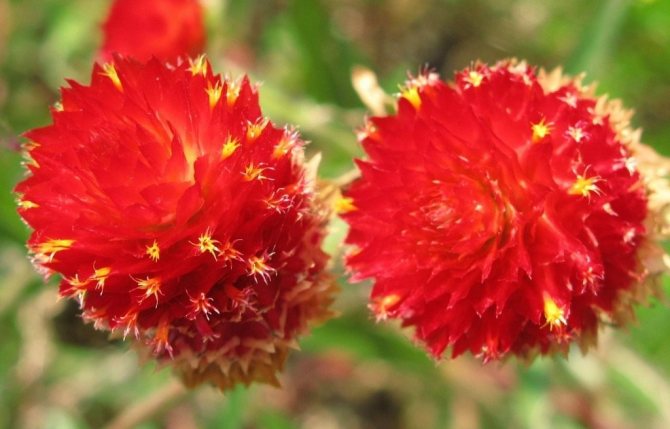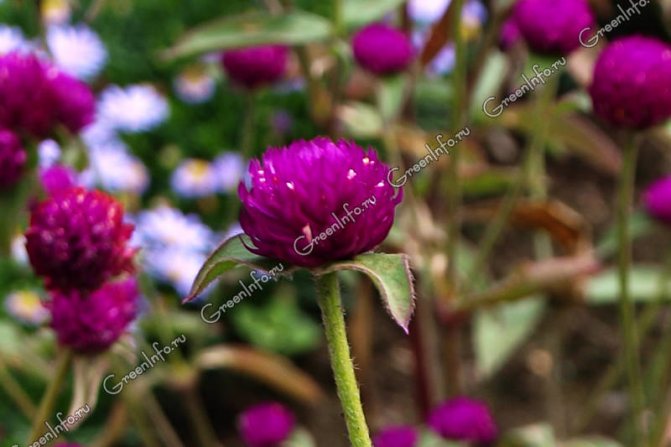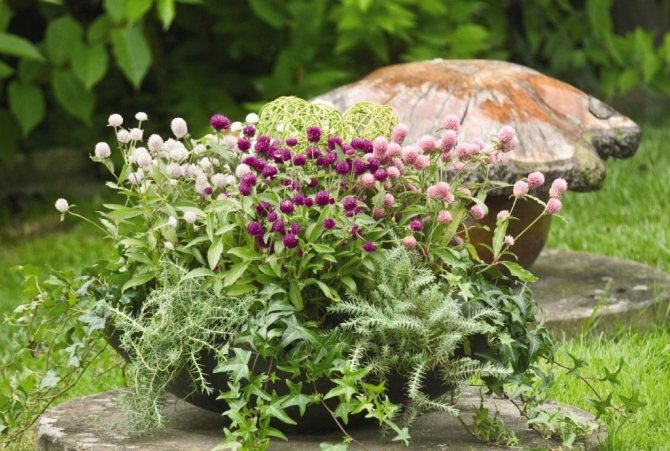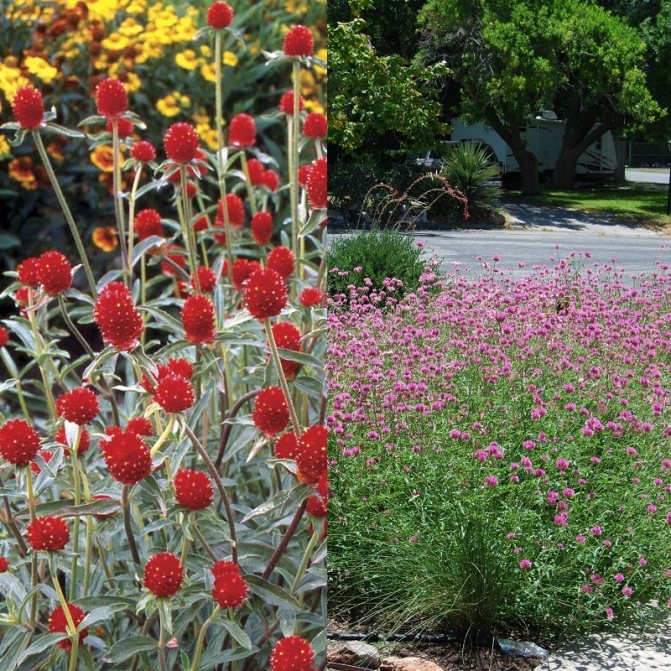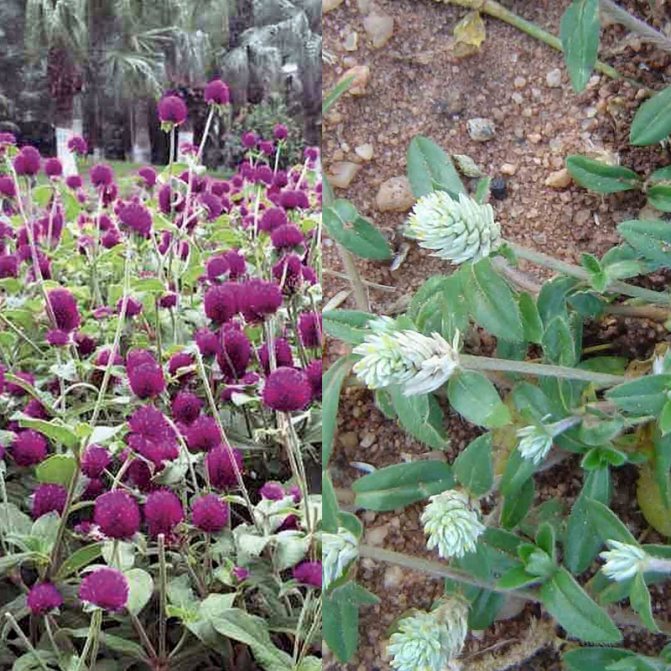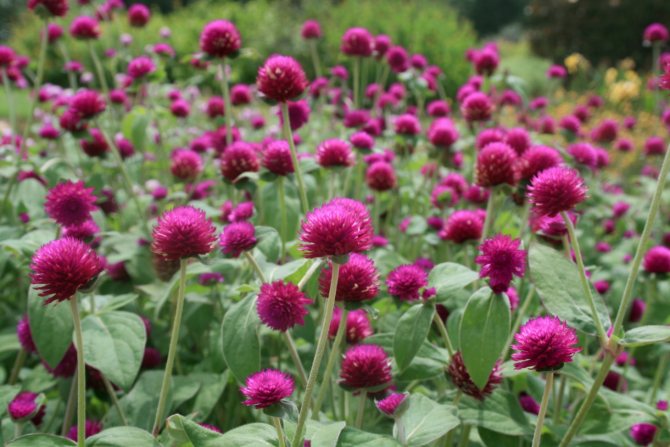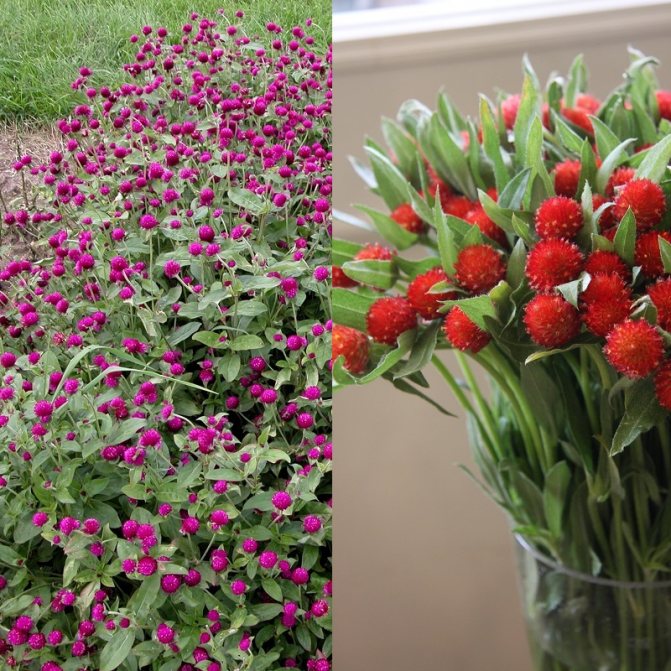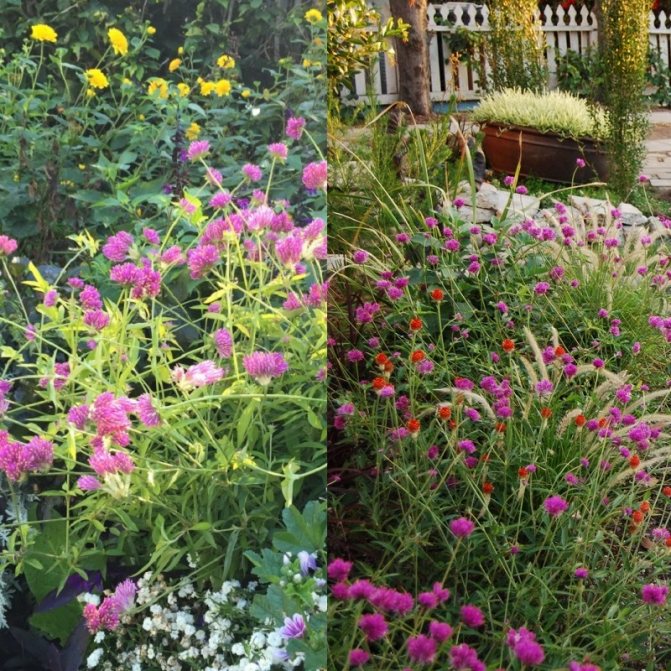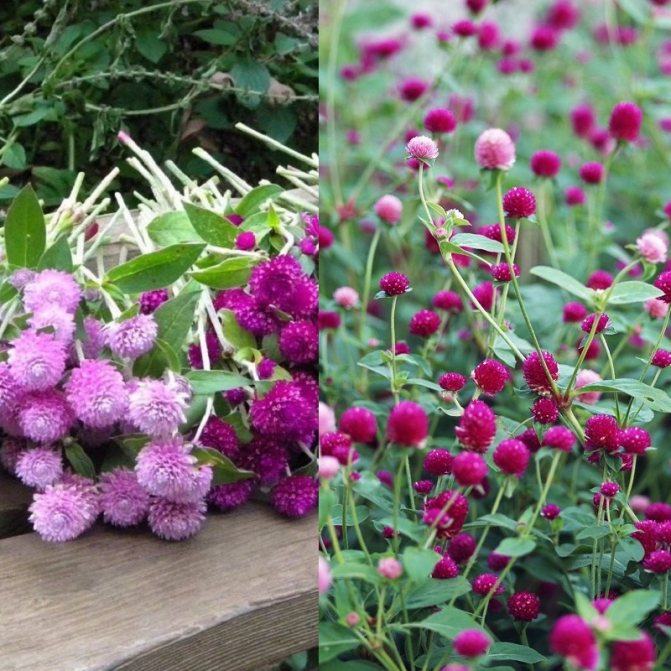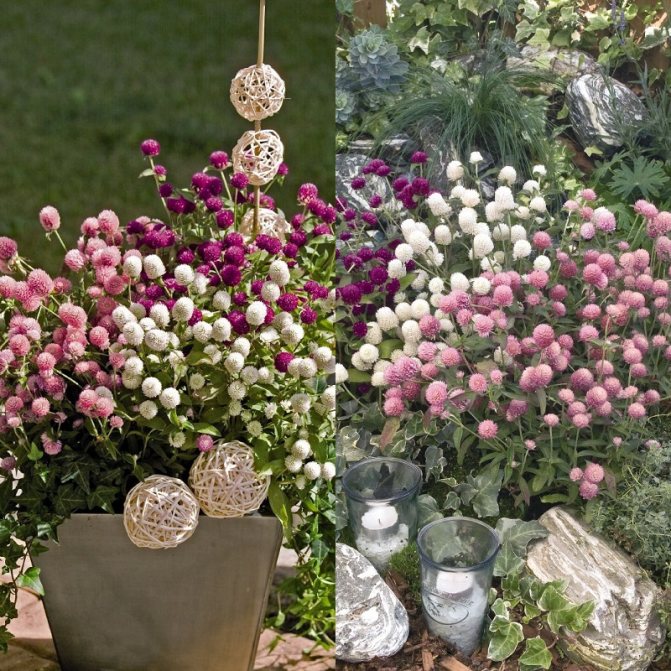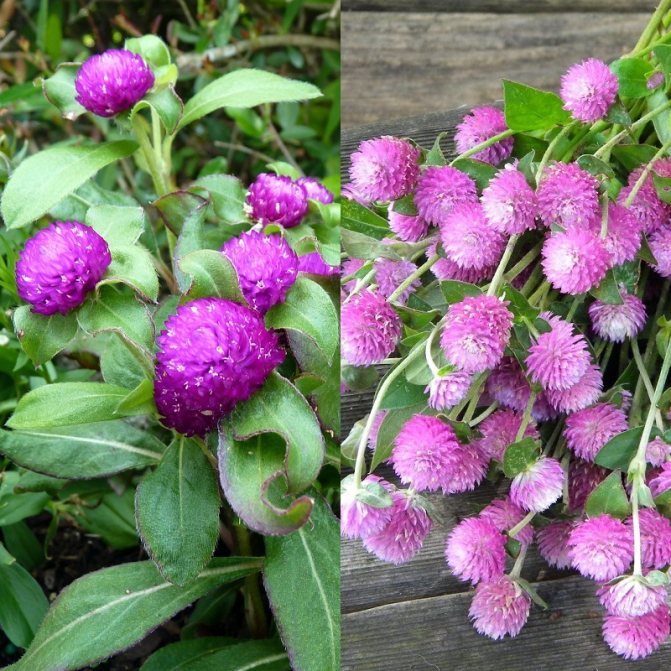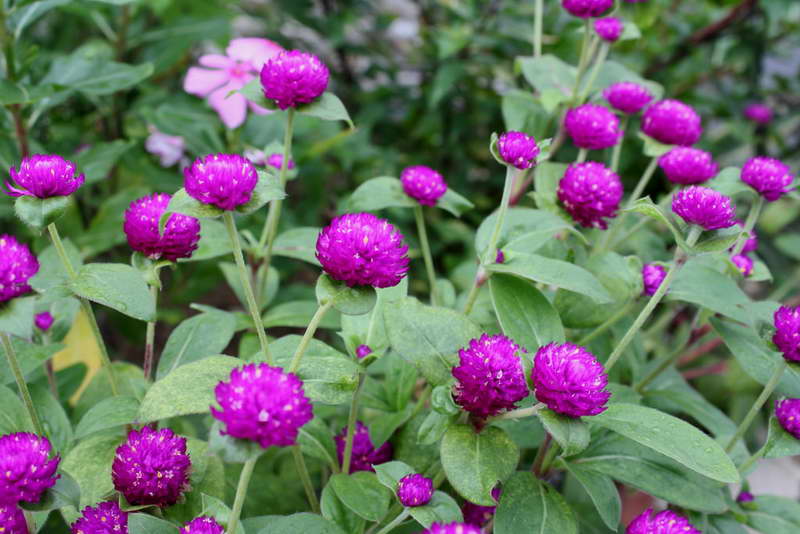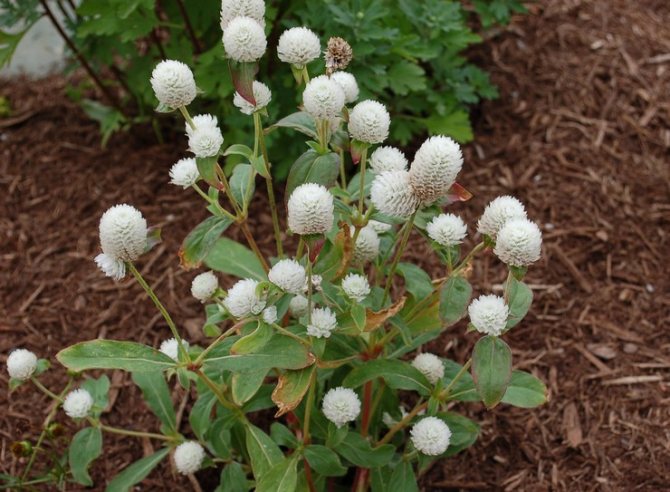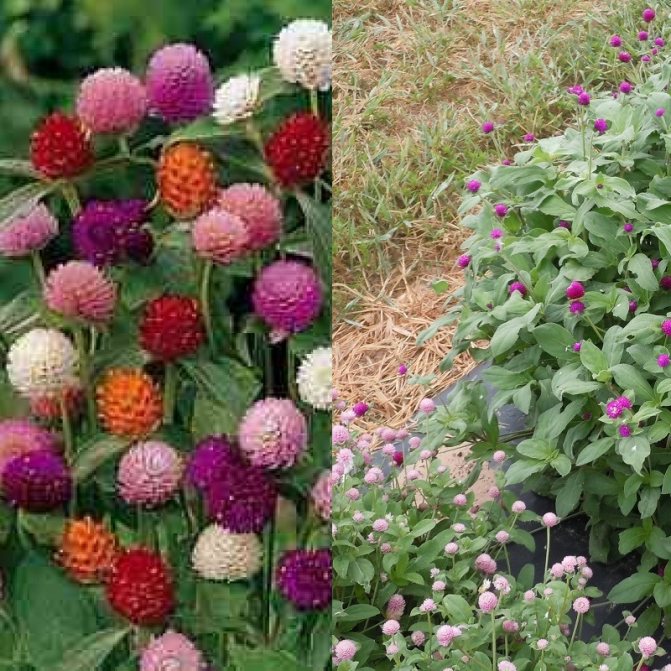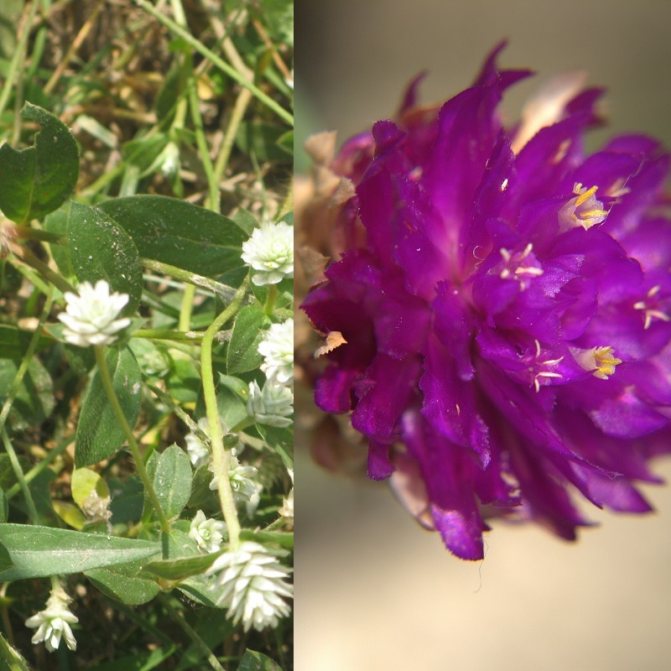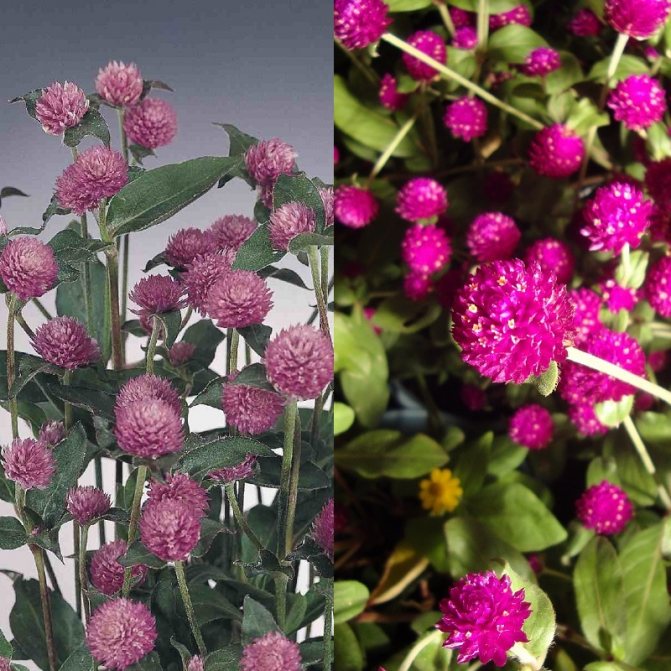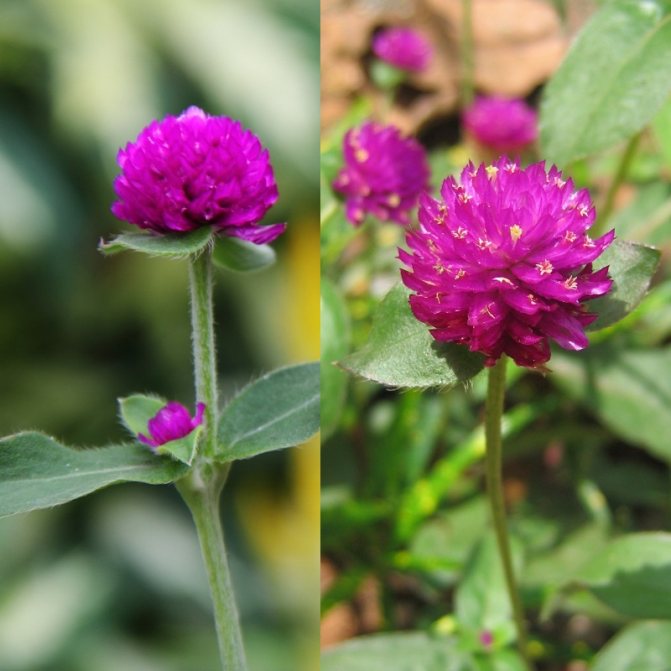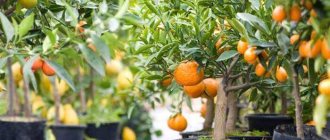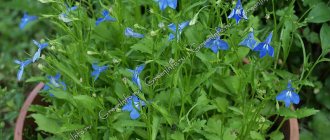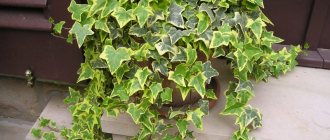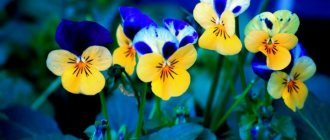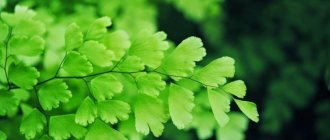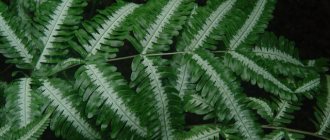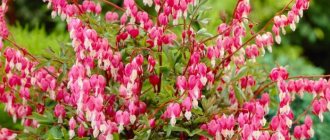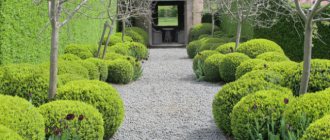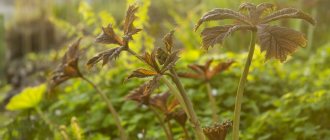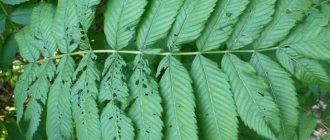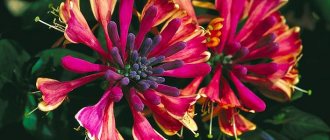The flowering plant Gomphrena is a member of the Amaranth family. In nature, it can be found in the tropical zones of the Southern and Northern Hemisphere. Delachen, who was a French botanist describing this culture, indicated that Pliny gave the name to Gomfren. Then it was included in the "Species plantarum" by Carl Linnaeus under this name. The largest number of species of such a plant is found in South America. This genus unites about 100 species, some of which are cultivated by flower growers as indoor plants.
Description
The genus Gomphrena unites more than 130 species of herbaceous one-, two- and perennials. These plants grow in the tropical zones of the globe, the greatest species diversity is noted in South America.

Gomfren stems are erect, ascending, open. As a rule, they are densely branched, covered with fine hairs. Entire leaves on the shoots are located opposite. In some species they are sessile, in others they are short petiolate.
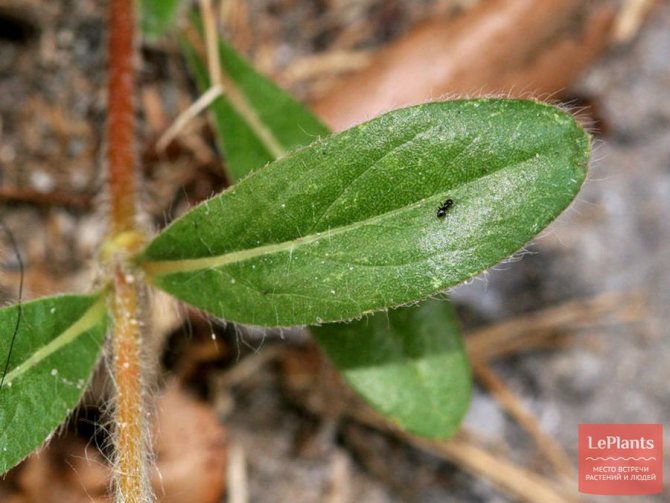

ON THE PICTURE: The bright or pale green leaf blades of Gomphrene are pubescent in most cases. Their shape ranges from elliptical to lanceolate.
At the tops of the stem and branches, single, sessile inflorescences are formed. They are spherical and spike-shaped. Bracts of tiny flowers are painted in all sorts of shades of red, white, purple, yellow color scheme.
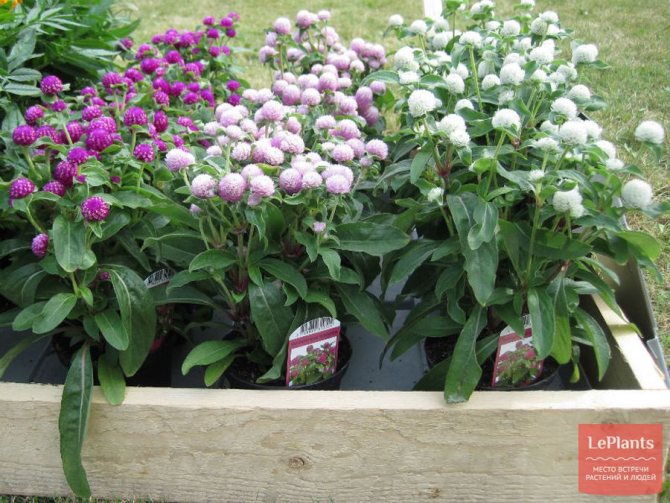

The fruits of the plant are non-opening capsules with one smooth seed.
Popular types
Gomfren has been grown for several centuries, but only three members of the genus have come into the culture.
Gomfrena Haage (G. haageana) with oblong inflorescences of red, orange, golden color.


ON THE PICTURE: Gomfren Haage.
Gomfrena serrata (G. serrata) with creeping stems and whitish-cream bracts.
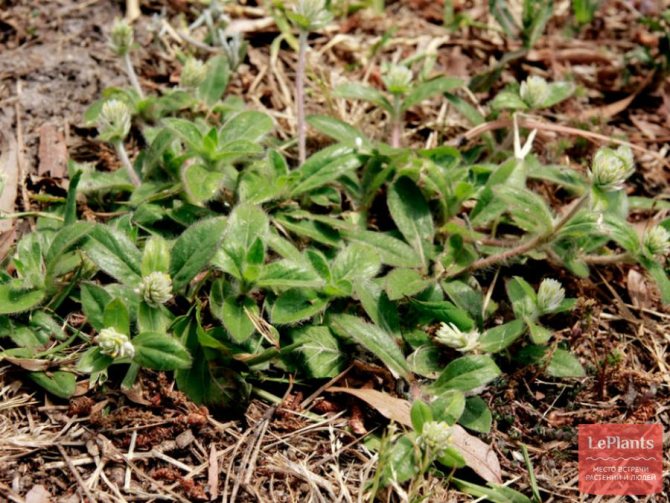

ON THE PICTURE: Gomphrene serrated.
Gomphrene spherical (G. globosa) - the most common type. The plant forms dense bushes with raspberry, purple, pink, white inflorescences.
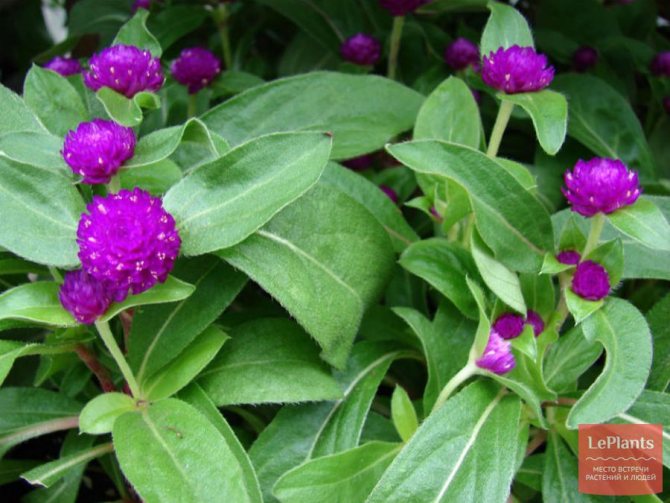

ON THE PICTURE: Particularly popular with florists are dwarf varieties bred on the basis of spherical Gomphrene, the height of which does not exceed 15 cm.
Gomfrena is suitable for ridges and borders, fits perfectly into group compositions. It can be grown both outdoors and in containers. It blooms from mid-summer to late autumn.
Cut plants retain their shape and color for a long time, which is why they are often used to create dry bouquets.
Types and varieties of gomphrene with photos and names
It was already mentioned above that the genus Gomfren consists of a large number of species, but only 3 of them are cultivated by gardeners.
Gomphrena globosa
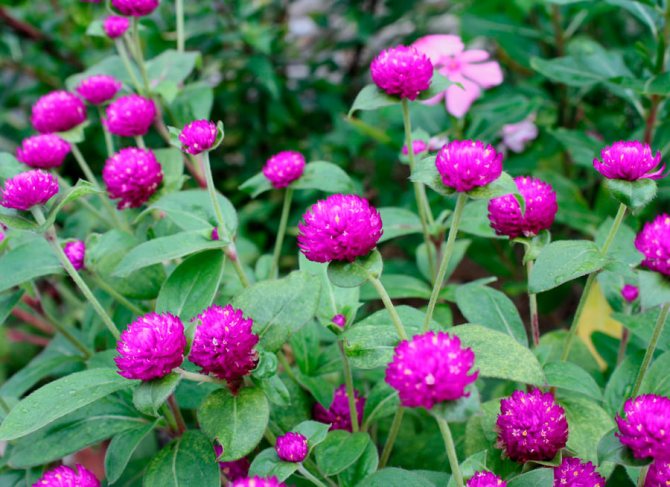

The height of the bush is 15–40 centimeters. Entirely short-peaked leaf plates have pubescence, due to which they have a bluish color. Globular capitate inflorescences reach 40 mm in diameter, they can be colored pink, lilac, purple, red, white or crimson. Bushes bloom in July, and fade before the onset of the first frost. Popular varieties:
- Bright Border... The height of the bush is about 0.3 m, the flowers are painted in a variety of shades of pink, up to carmine pink.
- Buddy... In this series, the bushes are about 15 centimeters high, while their flowers are colored purple, white or pink.
Other popular varieties are: Globoza, Raspberry Berry, Fireworks, Pompon and a series of Pixie mix and Gnome varieties.
Gomphrena haageana, or gomphrena golden-flowered
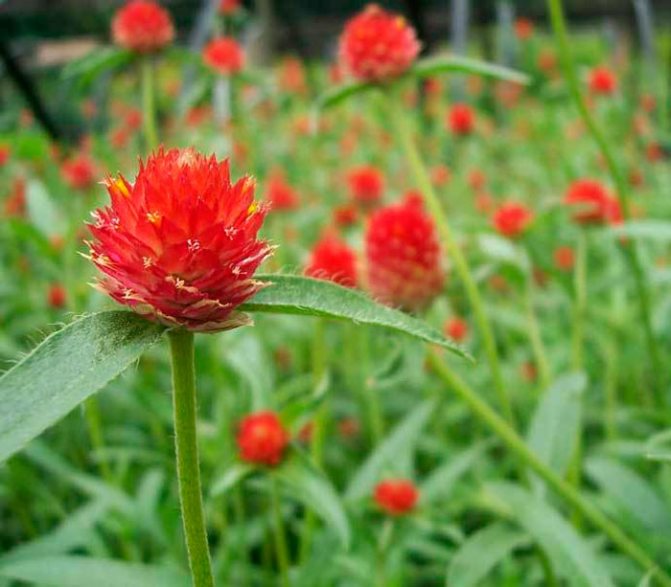

This species has been cultivated quite recently. It is similar to globular gomphrene, but its inflorescences are larger and have an orange and red color. It is distinguished by its thermophilicity, and if the summer period turns out to be cold, then the bushes may not bloom at all.
Gomphrena serrata
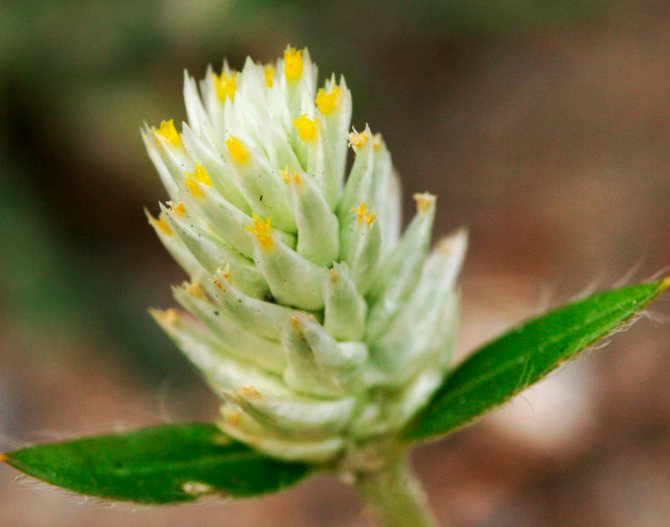

Very often this species is cultivated in suspended structures. Elongated leaf plates decorate the shoots that spread throughout the area, resulting in a carpet. Against its background, carnation-shaped inflorescences and orange-golden buds look very impressive.
The most popular variety is Pink Pinheads: the flowers are painted in a deep pink color, their color remains even after they dry up, in this regard, they are often used to compose winter bouquets.
Growing
Gomfrena is usually grown as an annual. Recommended to apply seedling method... Sowing seeds in open ground is possible only in the southern regions, but it should be borne in mind that flowering will come much later.
Seedlings start growing in mid-spring. The seeds are lightly pressed into the disinfected soil, covered with glass or foil. Until the emergence of shoots, the container is kept in a dark place, and then placed in the light. Seedlings need ventilation and moderate moisture. After another two weeks, a pick is carried out.
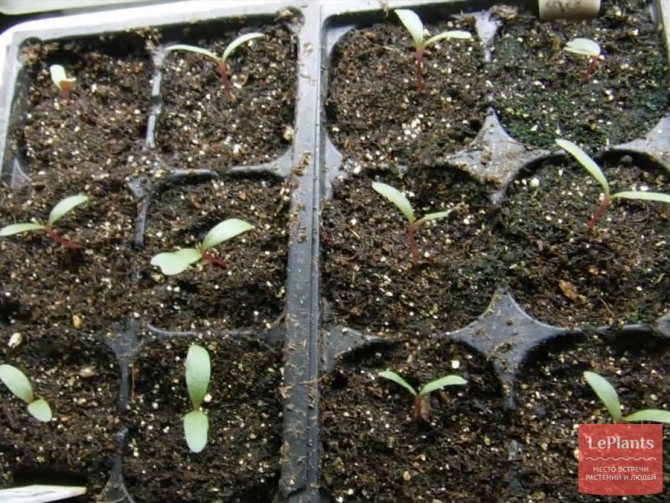

ON THE PICTURE: Plants are transplanted into open ground in May – June, when the risk of recurrent frosts completely disappears.
The landing pits are located at a distance of 15-30 cm from each other. After planting, the soil is compacted and watered.
To obtain seeds at the end of summer, the inflorescences are cut from the central shoots. They need to be wrapped in a cloth, wait until they dry completely and collect the seeds. They retain their germination capacity for 2-3 years.
Planting gomphrene in open ground
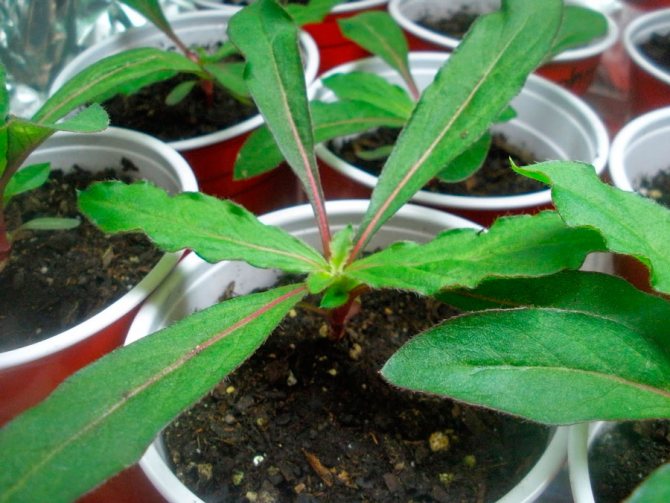

What time to plant
Gomphrene seedlings are transplanted into open soil only after the return spring frosts have been left behind, while warm weather should be established, and the soil should be warmed up. As a rule, this time falls on the last days of May or the first days of June. For growing gomphrene, you should choose a well-lit area that has reliable protection from drafts and gusts of wind. The soil should be neutral and not too nutritious.
Landing rules
Before proceeding with planting seedlings, the site will need to be dug up, but the soil is not fertilized. After the surface of the site is leveled, it is necessary to make planting holes, while when planting tall varieties, a distance of 30 to 35 centimeters must be observed between them, and between the undersized bushes it will be enough to leave 15 to 20 centimeters. The pits in depth should be such that the plant would fit in them along with a lump of earth. The plants must be passed into the prepared holes, they must be placed in the center, while trying not to injure the root system, and the free space in the holes is covered with earth. Around the planted plants, the soil is compacted and watered.
Success secrets
For Gomfrena, it is necessary to allocate a well-lit, warm, wind-protected area. For full development, plants require loose, air-permeable soil with a neutral reaction. The preparation of the territory consists in digging, destroying weeds, applying mineral fertilizers.
Gomfrena absolutely cannot stand organic matter.The use of manure, compost, humus leads to slow growth, poor flowering and even death of natural species and varieties.
The plant reacts extremely negatively to waterlogging. It is watered moderately in dry and hot weather, choosing the morning hours for the procedure.
The first feeding with complex mineral fertilizers is carried out a few days after planting in open ground. The next one will be needed at the budding stage, another one - during the flowering period. In the last two cases, fertilizers with a high content of calcium and phosphorus will be needed.
For dry bouquets, Gomfren is cut at different flowering times. It is important to be in time before the lower part of the inflorescences darkens.
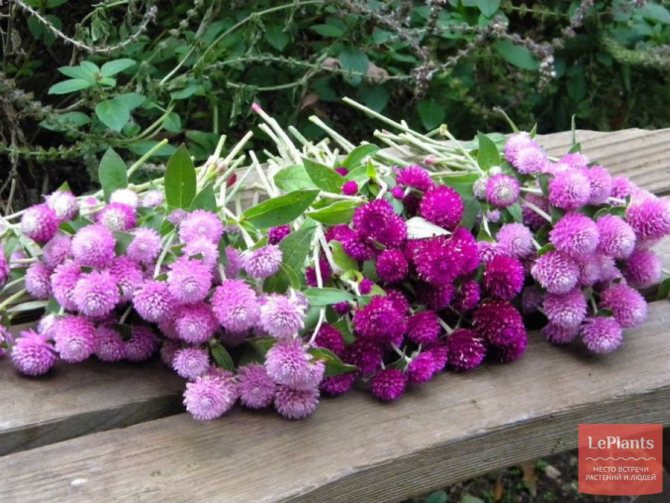

ON THE PICTURE: Cut plants are tied into a bunch, hung and dried in a warm, dark, ventilated place.
After cutting, Gomfrena manages to grow new flower arrows.
Gomphrene care in the garden


It is relatively easy to grow gomfren in your garden. Such a culture is distinguished by its unpretentiousness, therefore it is very easy to take care of the gomphrene. Bushes need timely watering, weeding, feeding, loosening the soil surface. To keep the plants beautiful and tidy, they will need regular small pruning. Such a flower is suitable for cutting, and it is noteworthy that the more often you cut the flowers, the thicker the bush and the more magnificent the flowering will be.
How to water and feed


Watering the bushes is necessary only during prolonged drought, while this procedure should be moderate. It should be remembered that such a crop is drought tolerant, so if you skip watering, then there will be nothing to worry about. However, water stagnation in the ground should not be allowed, since this may cause fungal disease, especially if cool weather sets in. If it rains systematically in the summer, then such a flower can not be watered at all, however, in this case, experts recommend that after the rain passes the next day, it is imperative to loosen the soil surface and pull out the weeds that have appeared.
You need to feed such a flower very carefully, since there should not be too many nutrients in the soil. For example, if there is a lot of nitrogen in the soil, then because of this, an active growth of green mass will begin, which will have an extremely negative effect on flowering, which may not occur at all.
Diseases and pests of gomphren
Gomphrene can only get sick if there is stagnation of fluid in the soil. The fact is that this culture has a very high resistance to diseases and pests. In rare cases, aphids can settle on it, which move to bushes from other plants. To get rid of aphids, you need to use insecticides, while all folk remedies in this case will be extremely ineffective.
Gomphrene pruning
This summer is not afraid of formation, but it is carried out only for potted gomfren. It is better to give the plant freedom and carry out cutting only for bouquets: in place of the cut inflorescence, new peduncles will grow from the axils of the leaves.
For dry bouquets, the inflorescences are cut at different stages of opening, thus obtaining differently colored balls, different in size. The inflorescences are most effective when the inflorescence reaches the size and stops development. But if you want to prepare gomfrena for bouquets, then try to remove the inflorescences before the lower scales in the inflorescence balls begin to brown.
Note: gomfrena is not only a decorative plant, but also a useful one. It is actively used in folk medicine as a strengthening immunity and a remedy after illnesses.
Examples of compositions
Bouquet with craspedia and ranunculus:
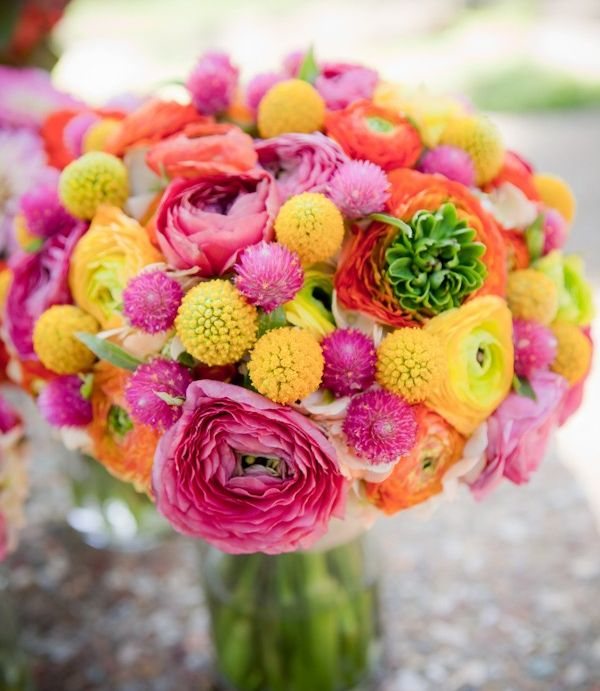

With zinnias
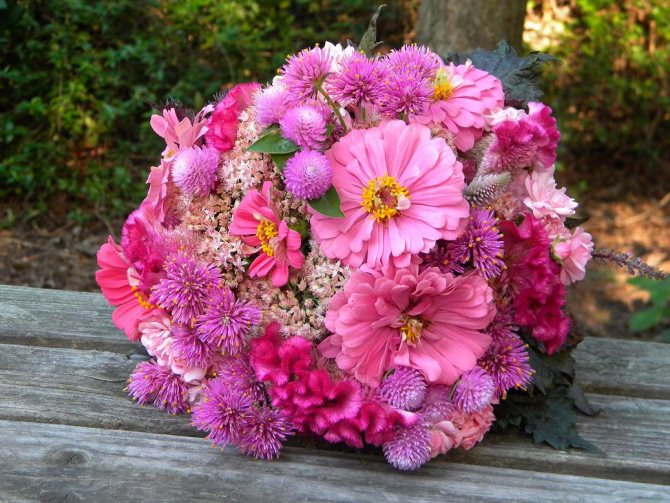

Bouquet of succulents, orange dahlias, craspedia, berzelia, gomphrene and scabiosa:


Gomfrena is good in autumn compositions, but off-season options are also possible. The bouquet below is composed of red English roses, gomphrene and geranium:
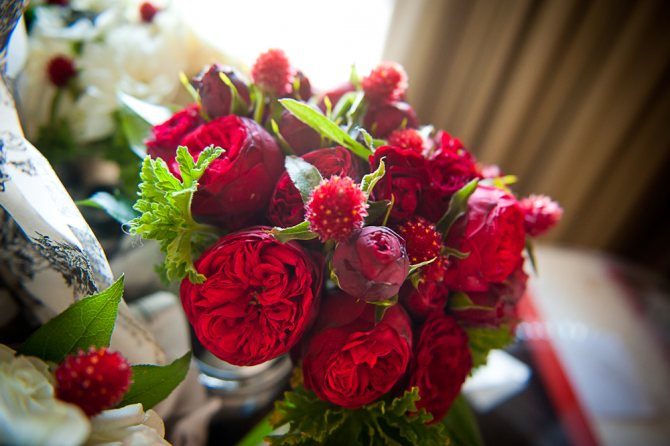

Varieties
The view is considered classic Gomphrena globosa), but there are also other, rarer species of this plant, on Photo which can also be viewed:
- scattered gomphrena (G. Dispersa);


- golden-flowered gomphren or gomphren Hage (G.haageana; gomfrena is distinguished by its special elegance, it was bred relatively recently);
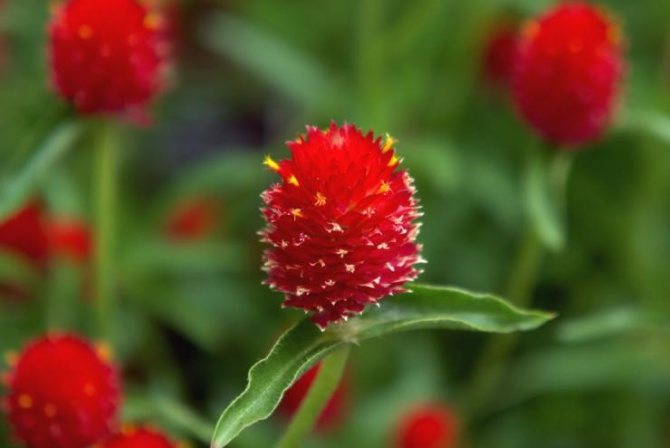

- dwarf;


- purple.
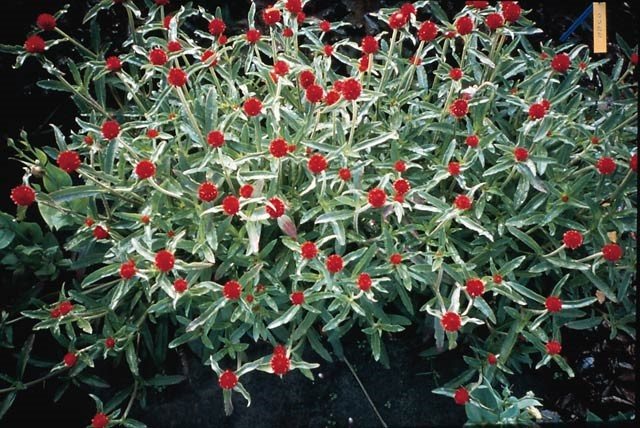

There are 90 plant species in total. Most of them grow in America, Australia and India. In the CIS countries, the most popular varieties are "Strawberry meadow" and "Berry glade".
Diseases and insects
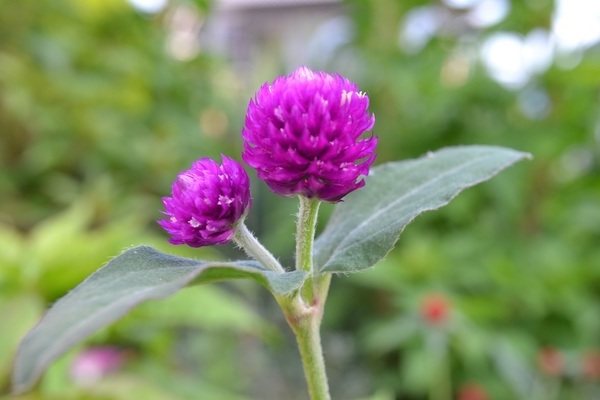

The plant can be susceptible to disease if water stagnates in the soil. it is important to note the fact that the plant has good immunity against various diseases and insects. it is very rare to find aphids, which can appear on a plant, having got over from a nearby bush. To combat aphids, special insecticides are used. Using folk methods will have a low effect.
Feedback
Knora:
“An annual plant, vigorous, branchy. Height 20 - 45 cm. It blooms long and very profusely. Small flowers are collected in almost spherical capitate inflorescences with a diameter of about 2 cm.
Color - purple, scarious bracts pink red, crimson, lilac. The plant is thermophilic and photophilous. Prefers loose soils, does not like waterlogging and drying out of the soil. Gomfren is grown by seedlings. Seedlings appear 7 - 8 days after sowing, and flowers - 80 - 90 days after germination. The plant belongs to real dried flowers, it is used for cutting for winter bouquets. "
Landing.
For earlier flowering, the flower is recommended to be grown by the seedling method. To do this, the seeds are sown in March in containers or pots, then at the right time and due to their inherent small size, they are placed on the surface of the soil, lightly sprinkled. Under this task, a site is determined with loose and nutritious soil, a low level of groundwater, well warmed up by the sun's rays and protected from through cold weather.
Seeds that have not lost their germination are actively germinating by the end of the second week. Seedlings are transplanted into the flower garden when the period of return of cold snaps and frosts is over. Before disembarking, it is hardened, taking it outside for about a week and increasing its daily stay in the open air by several hours.
More about the flower
Inflorescences of red, yellow, white or blue color give a special decorative effect to a fragile and low gomphrene. They are balls of unusual texture, the diameter of which is approximately 4-5 centimeters. Inflorescences are formed from small petals-scales tightly adjacent to each other. This original shape gives the flowers a unique look. They resemble colored cones or berries.
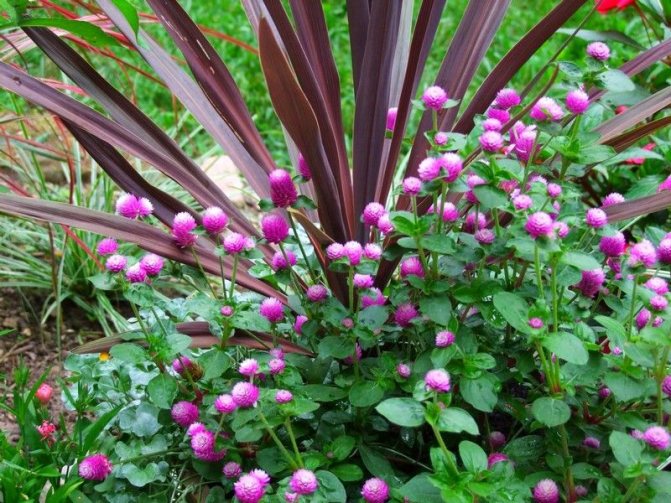

Adult specimens form compact bushes that blend perfectly with many garden crops and decorate the landscape of the backyard. Gomphrens are often grown for cutting. Bouquets in vases look great, but they are valued not only as fresh flowers. Correctly grown flowers can stand dead up to three years, therefore gomfren is also called "immortelle" (immortal).
Healing properties
Gomphrene is not only an excellent ornamental plant, but also has medicinal properties. It is used by traditional medicine in many countries in the treatment of cough, bronchitis, tuberculosis, helps to strengthen the immune system, to restore strength after a long or serious illness. Medicines (decoction, flower tea) cleanse the circulatory system and liver, remove toxic substances from the body, and charge the body with vitamins.
How to prepare a decoction: take 2 tablespoons of dried flowers, pour 300-400 milliliters of boiling water and let it brew for 7-10 minutes. The drink has a light sweetish aftertaste, it can be drunk warm and chilled.
To prepare flower tea, you need 1 tablespoon of dried flowers, which can be added to a teapot to regular black or green tea, pour boiling water (about 300 ml). Drink it 2-2 times a day.
Among more than a hundred species of gomphren, some are cultivated. Each of them is unique and good in its own way; many varieties have also been bred.
Gomphrena globosa Gomphrena globosa
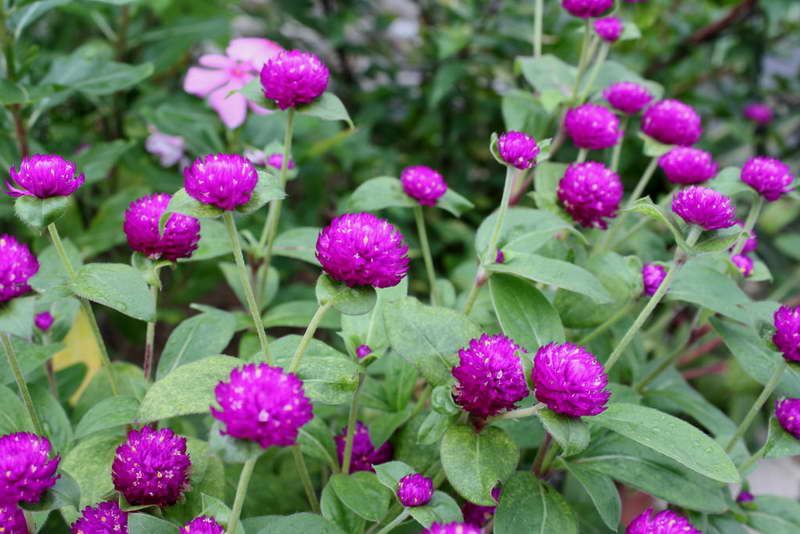

Gomphrena globular Gomphrena globosa photo
The most popular type of gomphrene. An annual with erect, strongly branching shoots, the height of the bush is about 35 cm (in warm southern regions it stretches up to 70 cm). Leaves, about 10 cm long, densely cover the stems, they are pubescent with gray pile. The color range of inflorescences includes white, cream, red, purple, orange shades. The diameter of the ball is about 6 cm. There is a dwarf variety (Gomphrena globosa var. Nana compacta) 15 cm high, with white and red inflorescences.
Varieties bred by breeders:
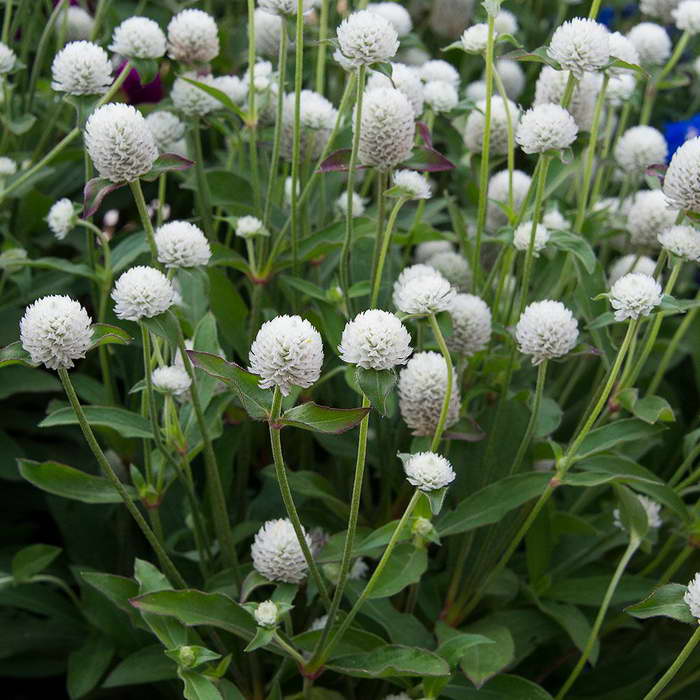

Gomphrena globular white in the photo variety Gomphrena globosa 'Ping Pong White'
Buddy White - snow-white inflorescences;
Baddy Purpur - purple inflorescences;
Baddy Rosea - light pink flowers;
Pixie Mix - lilac-pink or white-cream inflorescences.
All bushes are dwarf (15 cm high), with cute inflorescences-balls with a diameter of 4 cm.
Gomfrena purple
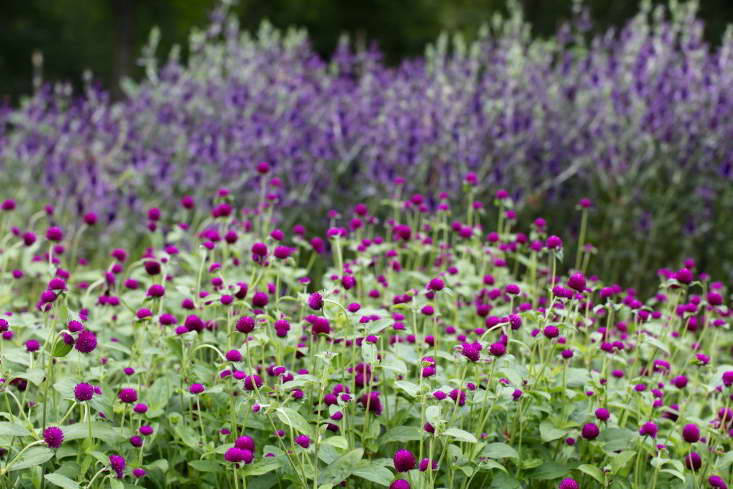

Gomfrena purple photo in the garden
A beauty with purple inflorescences forms a silky rug. Stems reach a height of 30 cm, rising.
Gomfrena strawberry
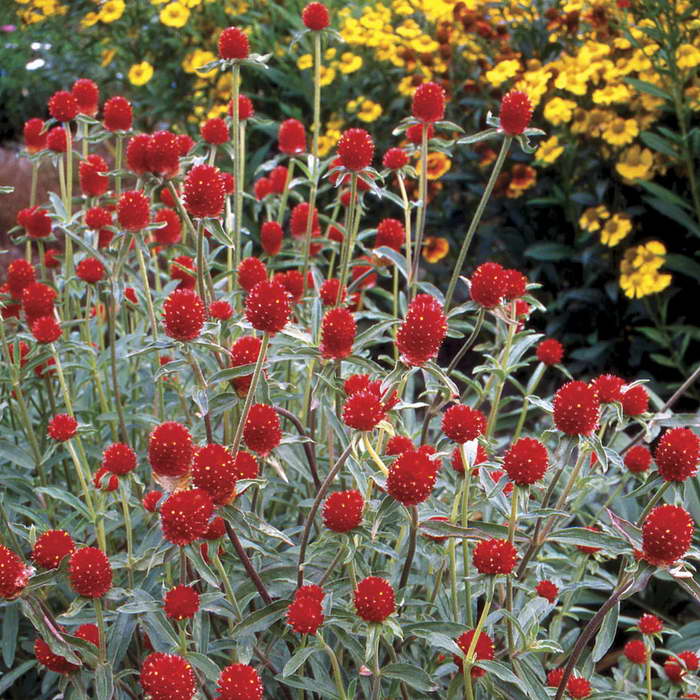

Gomfrena strawberry meadow photo
The plant has half-meter stems. The name of the species is given due to the spherical red inflorescences, reminiscent of the mentioned berry. Landing on the site looks like a strawberry meadow.
Gomphrena dispersa
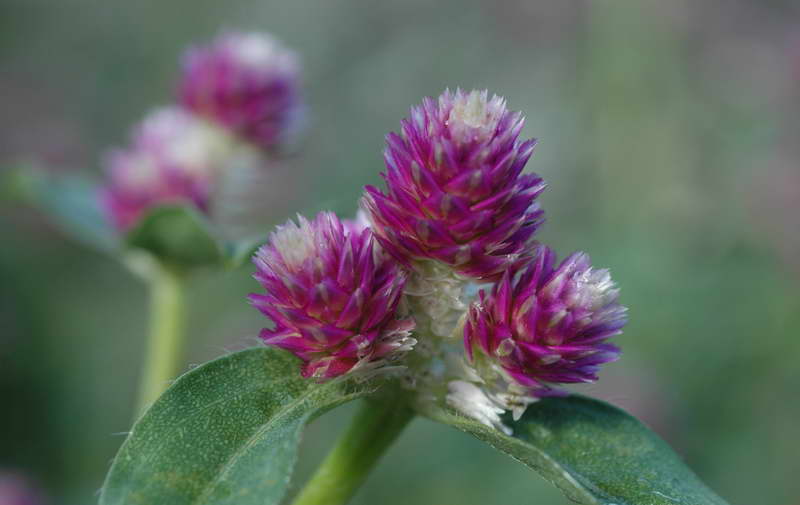

Gomphrena dispersa photo
It differs from other species in stems spreading, "scattering" along the ground, one bush is able to cover an area of 1 m². When grown in a pot, they hang down beautifully, take on a weeping look. Against the background of a green rug, inflorescences of an orange-golden hue look harmonious.
Pink Pinhea is the most remarkable variety of the species, the inflorescences are full of bright pink hue.
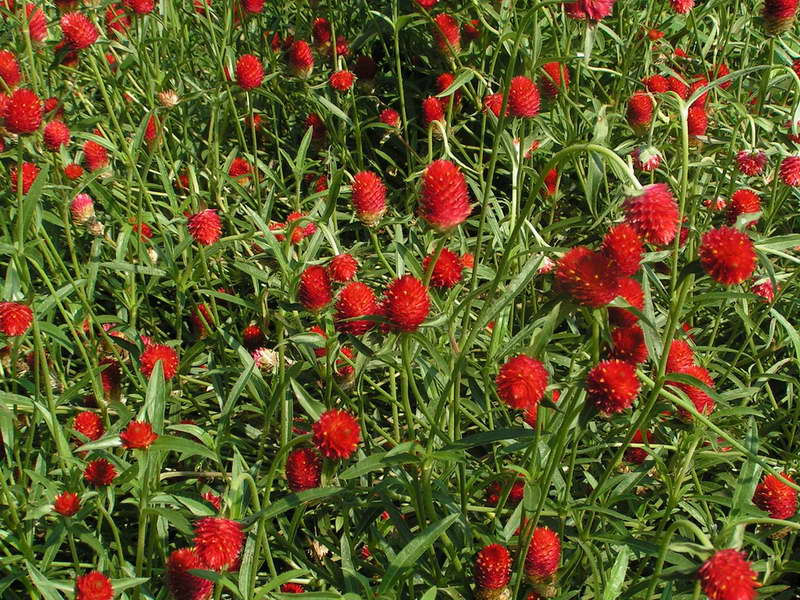

Gomphrena haage or golden-flowered Gomphrena haageana
Perennial gomphrene with stems 30-40 cm high. The leaf plates are elongated. The inflorescences are large, bright orange in color, with golden tips on flower petals.
Conditions comfortable for gomphrena
In order for this beauty to please with a large number of inflorescences-balls, she needs to be provided with the most brightly lit locations. Sunny, warm, open and south-facing areas are perfect for Gomfren. That is why it is recommended to plant it as spots on the lawn or on flower beds with other sun-loving summer gardens. Despite belonging to dried flowers, Gomfrena does not like the wind environment and it is better to protect it from active drafts.
It is even easier to find the soil for this beauty. Any fertile and loose soils are suitable for Gomfren.
For a potted gomphrena, they choose the sunniest places and a high-quality, universal soil mixture. The optimum soil is considered, consisting of equal parts of sod, leafy soil, sand and peat.
Benefit
"Gomphrene" is used as a medicinal plant. It is believed that the infusion of its inflorescences helps with coughs, bronchitis and even tuberculosis, as well as a general tonic, especially after serious illnesses.
In their flower beds and apartments, gardeners can grow many beautiful exotic plants. Here are some of them, about which there is information on our website: alocasia, orange, euonymus, asparagus, ginura, zamioculcas, pomegranate, coleus, arrowroot and selaginella.
At the end of the flowering of "Gomfrena" on the flower bed, her life does not end. The everlasting charm is a beautiful dried flower, which is widely used by decorators to create paintings, flower arrangements and simply interior decorations using various natural materials. Winter bouquets with "Gomfrena" are very good.
If you find an error, please select a piece of text and press Ctrl + Enter.
Diseases and pests
Gomfrena almost never gets sick. Possible defeat by cercospora (small brown spots appear on the leaves, bordered by a red stripe). Treat the plantings with a fungicidal preparation.
From waterlogging of the soil, rotting of the stem occurs, remove the affected areas, treat the plants with a fungicide.
Like dried flowers, gomfrene pests are not terrible. Very rarely, aphids can seize seedlings. It is enough to spray the plants with a solution of ash or laundry soap.
Winter period
The gomphren plant does not survive the winter very well. Annuals generally die during this period, and perennials try to survive until spring, but this is very difficult for them. If you decide to plant peers, then you should not worry so much, because in any case you will have to dig them up and prepare to plant new ones next year. If you have planted perennials, then the situation here is certainly more complicated. In this case, you need to transplant all the plants into pots and take them home in the warmth. But not everyone has enough room for more than 30 plants. In this case, an ordinary old carpet will help you, with which it is advisable to cover plants for the winter. The last method is to cut off the leaves and flowers so that the gomfrena blooms again next year. It would seem that the method is easy, but in fact it is the most deadly for flowers: the life of plants is reduced.
Multicolored photo
In the photo, the creation looks very unusual. It feels like someone took bright colors and painted dandelions with a brush. And most importantly, he approached this business creatively and used paints of different colors. In fact, of course, these flowers have little resemblance to dandelions, rather they are more like clover, but only larger in size.
The shape of the flower, which looks like a ball, and determined its name - spherical.
In the photo you can see long stems, on the tips of which there are a pair of green leaves, which, as if in their palms, hold a colored fluffy ball. But it is rather difficult to see real leaves, since they are located in the surface layer on short petioles. Gomphrens are low (up to 30 cm) herbaceous annuals representing the amaranth family. The color of the flowers and the shape of the leaves vary depending on the variety. Currently, the following are especially popular: globose (gomphrena globosa), purple. The scattered, gomphrena haageana is no less famous.
Of the above, the most interesting for florists is scattered. This species is thermophilic. If there is no support nearby, then it can branch and crawl.
Possible problems
Like all plants, gomfrena can be affected by various diseases. This is not always associated with poor care. Basically, the flower can suffer:
- from the attack of aphids;
- from fungal diseases;
- from cercosporiasis.


Aphids rarely attack gomphren. But if this happens, then the affected plant can either be treated with an aqueous solution of ash (ash is dissolved in water), or you can buy an insecticide at a gardening store. You need to use it in accordance with the instructions.
Cercosporium disease is called "leaf spot". This type of fungus affects many plants, causing severe deformation of the stem and spots on the leaves. Sick flowers must be treated with a fungicidal preparation.
Remember
- Prepare the soil. The soil for sowing seeds is prepared in advance in a ratio of 1: 1 fertile soil layer and humus. The plant grows well and develops in fertile, loose soil.
- Soak the seeds in water for 3 days... Then stratify in the refrigerator for good germination.
- Right look after. Plants need to be watered regularly, loosened the soil, and fed twice a season.
- Collect seeds in time. Seeds are harvested in September. Dry the cut inflorescences and store in a dry, warm place.
Seed collection
On the first buds, they ripen by the end of August.These are, as a rule, the central shoots. You need to choose the largest of them and tie with gauze, since the seeds easily crumble to the ground. After that, the shoots are cut and placed in a well-ventilated place until the balls are completely dry. After that, you can husk the grains, which are located in the lower cells.
It is necessary to collect flowers for seeds with a margin, since dummies are often found among them.
Use in landscape design
The variety of varieties allows you to use gomfren in almost any flower arrangement, and not only in a home garden, but also in city flower beds and parks.
- Low-growing plant varieties will be an excellent decoration for rock gardens, giving them a natural natural look. In combination with asters, these types will emphasize the geometry of the ridges and other flower beds. The unique ability to grow into a dense blanket makes Gomfren ideal for landscaping curbs around paths.
- Types of flower with high stems are perfectly combined with other shrubs in rockeries. Mixborders and ordinary flower gardens will also benefit from the presence of gomphrene due to its long flowering and preservation of its appearance even in the fall.
- The voids between the compositions in landscape design will be perfectly filled by a creeping scattered or dwarf gomphrene.
The uniqueness of the plant lies in the fact that it not only perfectly decorates garden beds, but also looks great in pots in a home interior.


